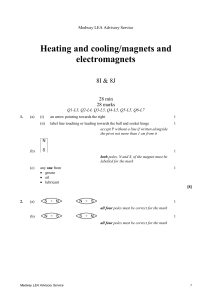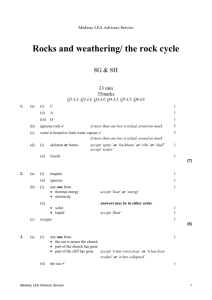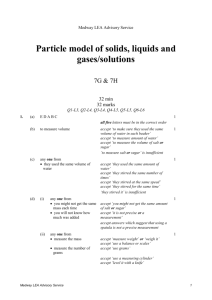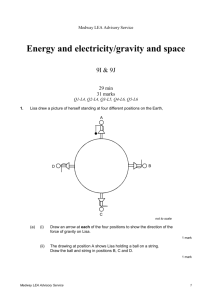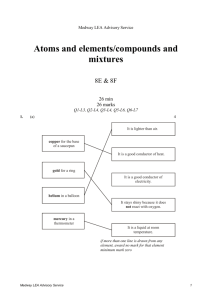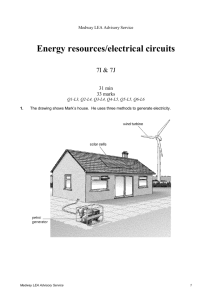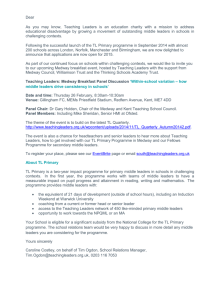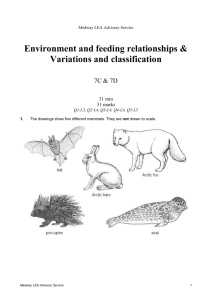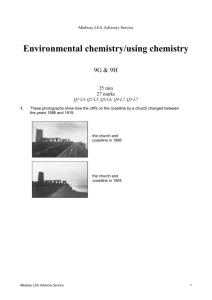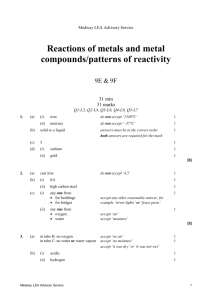Heating and cooling/magnets and electromagnets
advertisement
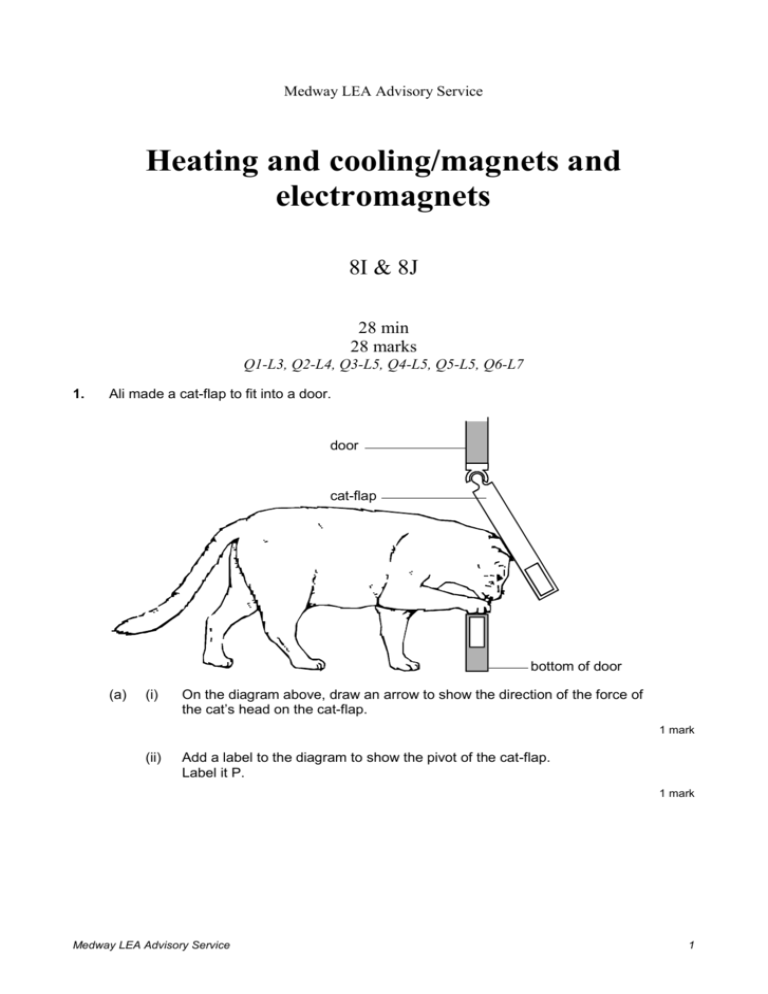
Medway LEA Advisory Service Heating and cooling/magnets and electromagnets 8I & 8J 28 min 28 marks Q1-L3, Q2-L4, Q3-L5, Q4-L5, Q5-L5, Q6-L7 1. Ali made a cat-flap to fit into a door. door cat-flap bottom of door (a) (i) On the diagram above, draw an arrow to show the direction of the force of the cat’s head on the cat-flap. 1 mark (ii) Add a label to the diagram to show the pivot of the cat-flap. Label it P. 1 mark Medway LEA Advisory Service 1 When the cat has gone through the cat-flap, the weight of the cat-flap makes the flap close. door cat-flap magnets N S bottom of door (b) Ali used two bar magnets to keep the cat-flap closed, so that it does not blow open in the wind. On the diagram above, label both the North and South poles on the magnet in the cat-flap. 1 mark (c) Friction at the pivot made the cat-flap squeak. What could Ali put on the pivot to make the friction less? ………………………………… 1 mark Maximum 4 marks Medway LEA Advisory Service 2 2. A compass needle is a small magnet with a North pole, N, and a South pole, S. Ruth placed two compasses onto a piece of card. Both compass needles pointed in the direction shown below. card compass N N S S compass needle (a) Ruth placed a bar magnet with its South pole between the two compasses. The compass needles moved as shown below. On the diagram below, label the North pole and South pole of each compass needle. Use the letters N and S. bar magnet 1 mark Medway LEA Advisory Service 3 (b) Ruth turned the bar magnet round so that the North pole was between the two compasses. On the diagram below, label the North pole and South pole of each compass needle now. Use the letters N and S. bar magnet 1 mark (c) Ruth repeated her experiment with an aluminium bar instead of a bar magnet. What happened to the compass needles? ..................................................................................................................... 1 mark maximum 3 marks Medway LEA Advisory Service 4 3. Luke investigated the heating of water. He predicted that the rise in temperature would depend on the volume of water. The diagram shows the apparatus he used. thermometer stiring rod 3 100 cm beaker water candle block Luke recorded his results in a table as shown below. beaker volume of water, in cm3 temperature at start, in °C temperature after 2 minutes, in °C A 25 18 30 B 50 18 24 C 75 18 22 (a) Why did Luke need to know the temperature of the water at the beginning and at the end of the experiment? ..................................................................................................................... ..................................................................................................................... 1 mark (b) Did Luke’s results support his prediction? Explain your answer. ..................................................................................................................... ..................................................................................................................... 1 mark Medway LEA Advisory Service 5 (c) Luke stirred the water during the experiment. How did this make his results more reliable? ..................................................................................................................... ..................................................................................................................... 1 mark (d) Which of the following statements about the energy transferred to the beakers is correct? Tick the correct box. Much more energy went into beaker ‘A’ because its temperature increased the most. The same amount of energy went into all three beakers. Beaker ‘C’ received the most energy because there was more water to heat. 1 mark (e) After a time, all three beakers cooled down to room temperature. What happened to the thermal energy in the beakers as they cooled down? ..................................................................................................................... ..................................................................................................................... 1 mark Maximum 5 marks Medway LEA Advisory Service 6 4. (a) Debbie put a paper cup into a glass beaker. She glued a magnet in the bottom of the paper cup. She glued another magnet in the bottom of the beaker. The magnets repelled. paper cup N magnet S S magnet glass beaker N diagram A not to scale What two forces act on the paper cup and its contents to keep it in this position? 1. ........................................................... 1 mark 2. ........................................................... 1 mark (b) Debbie put 5 g of aluminium rivets into the paper cup. It moved down a little as shown in diagram B. N aluminium rivets S S N diagram B not to scale Medway LEA Advisory Service 7 Debbie plotted a graph to show how the mass of aluminium rivets affected the distance the cup moved down. 6 5 4 distance paper cup moved 3 down (mm) 2 1 0 0 (i) 10 20 30 40 mass (g) 50 60 Use the graph to find the mass that made the cup move down 4 mm. ............... g 1 mark (ii) Why did the graph stay flat with masses greater than 40 g? ............................................................................................................. 1 mark (c) Debbie removed the 5 g of aluminium rivets and put 5 g of iron nails into the cup. N S iron nails S N diagram C not to scale Medway LEA Advisory Service 8 The paper cup moved down more with 5 g of iron nails than with 5 g of aluminium rivets as shown in diagram C. Give the reason for this. ..................................................................................................................... ..................................................................................................................... 1 mark maximum 5 marks 5. The back window of this car contains a heating element. The heating element is part of an electrical circuit connected to the battery of the car. The diagrams below show two ways of connecting the circuit of a heating element. circuit A Medway LEA Advisory Service circuit B 9 (a) Give the name of each type of circuit: circuit A ................................................................... circuit B ................................................................... 1 mark (b) A wire gets broken at point X on circuit A and at point Y on circuit B. Y X circuit A circuit B When the switch is closed, how does the broken wire affect the heating element in: (i) circuit A? ............................................................................................ ........................................................................................................... 1 mark (ii) circuit B? ............................................................................................. ............................................................................................................. 1 mark (c) In very cold weather, ice may form on the back window of the car. When the heating element is switched on, the ice will disappear and the surface of the window will become clear and dry. (i) Fill the gap below to show the energy transfer that takes place. When the heater is switched on, ........................................ energy is transferred from the wires to the ice. 1 mark (ii) As the window becomes clear and dry, physical changes take place in the ice. Fill the gaps below to show the physical changes which take place. from …………………. to ……………………….to …………………… 1 mark Maximum 5 marks Medway LEA Advisory Service 10 6. (a) In an iron rod the particles vibrate. If one end of an iron rod is heated, the vibrating particles transfer energy to neighbouring particles which are not vibrating so violently. What is this process called? ……….……………………………… 1 mark (b) An electric immersion heater is put at the bottom of a large tank of water. The water next to the heater becomes warm. (i) What will happen to the warmed water next to the heater? Give a reason for your answer. ………………………………………………………………………………… ………………………………………………………………………………… ………………………………………………………………………………… 2 marks (ii) Why can heat not be transferred in this way in an iron rod? ………………………………………………………………………………… ………………………………………………………………………………… 1 mark (c) In a liquid, some of the particles have enough kinetic energy to escape from the surface. This process happens even when the liquid is well below its boiling point. (i) What is this process called? ………………………………………………. 1 mark (ii) How will this affect the temperature of the liquid left in the container? ………………………………………………………………………………… 1 mark Maximum 6 marks Medway LEA Advisory Service 11
